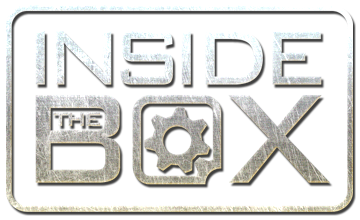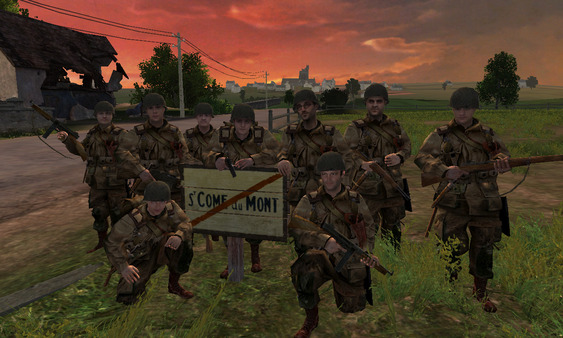
Inside the Box serves as a forum for individuals involved in the production of Gearbox Software content to share personal motives, methods, process and results. Gearbox Software projects are created by a diverse range of individuals spanning a spectrum of different backgrounds, interests, objectives and world views. The views and opinions expressed in this article are those of the author and do not necessarily reflect the official policy or position of Gearbox Software or any of its individual members outside of the author.
Though we’ve spent the last few Inside the Box articles discussing Borderlands 2 exclusively, Gearbox has a long and storied history of equally badass (and psycho-free) franchises. For this week’s Inside the Box, we look back Brothers in Arms: Road to Hill 30, the first entry in Gearbox’s realistic and critically acclaimed WWII strategy-shooter franchise.

In the following article, you’ll hear lead designer of multiplayer and current Borderlands franchise director Matthew Armstrong talk about the process of designing a BiA multiplayer mission, playtesting that multiplayer mission, and arguing with programmers.
PART 0: INTRODUCTION
There were two missions chosen for the very first prototype of Brothers in Arms Multiplayer. They were “Ambush at Anterbien” and “Crossroads at Pellerin”. Both were straight forward missions with single objectives. Of the two, “Ambush at Anterbien” was the first one created, so I thought I might trace the evolution of this first ever Mission.
PART 1: DESIGN
The initial design process is simple. I and one other designer sit in a room with a whiteboard and go over actual WW2 missions. This is easy, because there were hundreds of missions carried out during the D-day invasion and thousands more over the next few months. We look for a good variety of objectives, locations, and entertaining combat possibilities. Then we use those missions as inspiration for the missions that will go in the final game.
The very first mission we agreed upon was “Ambush at Anterbien”. It is as simple as a game of Red Rover. The Americans are trying to get through a town, and the Germans are trying to stop them.
For every mission, we created a simple design document that would present the basic layout, mission objectives, back story, and any other key details we felt were important. It is an intentionally ‘loose’ document, allowing freedom to evolve.
PART 2: PROTOTYPE
Once the document was done, the first version of the mission needed to be built. This was the simplest working version of the level. There is almost no cover and no detail. It is not much more complex than the simple picture from the design document.
You can see, however, that evolution has already begun. The road does not go across the rivers twice, but only across once at the exit point. This came from a simple logical question, “Why would the Americans bother when they could just ford the river to the south?”
It also helps make the exit point more distinctive and a better landmark for gameplay if there is only one bridge.
There are four images I present. First is the American spawn area, showing a simple road. Second and third are the German spawn areas, showing empty fields, and last is the overview, showing you the overall blandness of this version.




PART 3: SIMPLE EVOLUTION
After some time, we brought Ambush up to a true prototype. While the game ran before, it wasn’t really “playable”. In this version, it is. It’s not too much fun yet, but it works. You can see that the houses are more detailed, there are more trees, and there is grass on the ground. More importantly from a gameplay standpoint, there is now a crater at the American spawn exit allowing the Americans some cover. There are several low peanut shaped hedgerows that provide a bit more cover throughout the level, and there are Jeeps at the exit point.




PART 4: THE LATTICE OF FUN
Of course, if you know anything about Brothers in Arms you know “Suppress and Flank”. There is a simple rule:
-In single player, every enemy position should have a flank.

This is, perhaps, too simple, because by “flank” we mean “way to attack”. Usually it is a flank. But in Multiplayer, you are also the enemy of a player, so the rule becomes:
-For every position, there must be a flank.
And then because every flank is itself a position you get this rule:
-For every flank, there must be a counter-flank.

And if you follow this concept to its logical conclusion, you get:
-Every position must be a flank.
-Every flank must have a counter-flank.
-Every counter-flank must have a counter-counter flank.
-And so on…
And it becomes clear that we must build a lattice. It shall be the Lattice Of Fun.

Not every position has a full lattice around it, but every position will have its own strengths and weaknesses.
After a while, we found that having one or two positions in a mission that are particularly powerful and difficult to flank but had one or two significant weaknesses made for an interesting problem for both teams. We call these positions “fortresses”. Some are highly vulnerable to grenades. Some have limited visibility. Some are protected on many sides, but completely exposed in one direction, and almost all fortresses limit your escape or quick maneuver options. With the lattice, fortresses, and variety of cover and situations, we have limitless possibilities in each and every mission.
PART 5: WHERE WALLS GO TO DIE
And so with the Lattice and Fortress in mind, we evolved Ambush yet again. We realized that the north and south sides were too similar so we decided to put some walled in fields on the north side. It would allow us to create a strong lattice and also keep the two areas distinctive. If the Americans go north, they will have the benefit of open cover and many good firing positions, but they will be easy to spot. If they go south, the cover is high, allowing for less open combat but more severe choke points.




While it’s a nice lattice, a minor problem was presented by one of our programmers. The conversation went something like this:
‘That’s a lot of damn walls,’ said the programmer, ‘what the hell.’
‘It is our Lattice of Fun,’ proclaimed the designer with glee.
‘It’s a Lattice of Dumb,’ responded the programmer, ‘we aren’t shipping with that, are we? It looks like the place where walls go to die. Seriously, what the hell.’
And so, despondent and saddened by the programmer’s evil tirade, we looked at the mission with fresh eyes. We quickly came to realize that we hate this programmer oh so very much, but he was generally pretty right – which actually is probably why we hate him.
‘Besides, nobody builds walls like that,’ said the programmer who had rudely burst into the room, ‘I mean crap, guys, it’s a wall graveyard.’
‘Get the hell out of our room,’ I suggested.
PART 6: FINISHING TOUCHES
He was right. So we rebuilt the walls in a logical manner, and added some other forms of cover in that area where needed. The Lattice of Fun still exists, but is now hidden within wood piles, fallen trees, barrels, tractors, hills, and a great variety of other things. It’s more natural, but there is always an option. There is always a flank.
This is a near final version of the mission. The water and sky are missing, because new water and sky were being created. We added a second pond to the south which helped keep the area distinctive and provided a few more choke points to make the north vs. south choice interesting.




But we still had a few final issues. The testers discovered that the best game plan was not to go north or south, but to simply run straight up the middle with possibly a jog or two. There are hedgerows lined up in such a way that you can get away from enemy fire quite quickly if you followed this simple path.

We decided it was time for the Germans to take matters into their own hands. It’s their Ambush, after all. So they introduced a new fortress in the town by putting dragon teeth in the middle of the road. There is also now a fallen tree to the south, preventing an easy jog option. Running straight up the middle will often result in the Americans dropping their important documents right in front of the most defendable location in the town. It is now a risky move.

PART 7: GETTING IT DONE
And with polish, testing, and time we have a final version. The north is a tactical battleground where you are always behind cover, yet always visible. The south is slow, but well protected. The road is dangerous, but fast. This is one of our smallest missions, but there are many options and a good variety of combat situations.
The sky and water are in place, and they look lovely. We have artillery going off in the area as well, just as the design doc called for many months ago.



 ?
?PART 8: AMBUSH AT ANTERBIEN
I hope you appreciated this view into the creation and evolution of a single mission. This same process occurred for every multiplayer mission in Brothers in Arms. We took great care to balance and polish each Mission. They are varied in not only objectives, but play styles and combat situations. Each Mission is unique, and as you play you will quickly get to know them by name.
Though Brothers in Arms: Road to Hill 30 was Gearbox’s first original IP, we’ve tried to use the basic design philosophies noted here in all of our games. From BiA to Borderlands, there’s always value to be had in iteration, discussion, and politely asking people to get the hell out of your room.
The entire Brothers in Arms series is available on Steam here; Hell’s Highway in particular is available digitally on PSN and Xbox Live.






